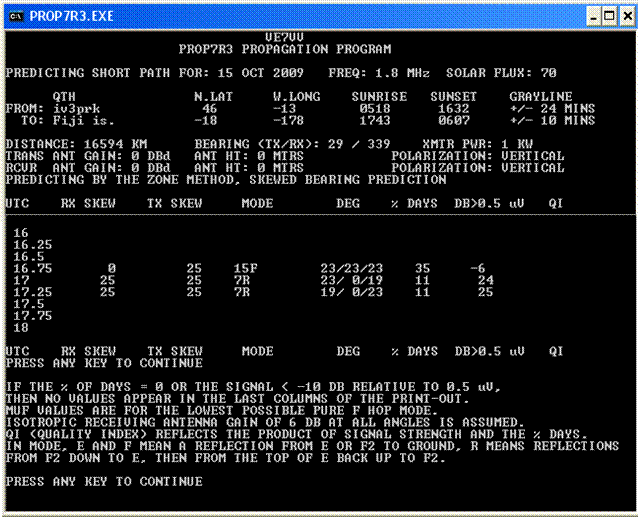October 2009 : 3D2KJ DXpedition by Jacek SP5DRH ßBackß
In October we had so many DXpeditions in rare islands which gave a lot of new ones to everybody: FT5GA and TO7RJ in Africa, ZY0T in South America, but specially 3D2KJ, 3D20CR, H44MY, TX5SPA, YJ0CCC and the big one from Midway, K4M. Most, but not all, European Topbanders, with good receiving antennas, successfully worked these stations on such long and tough paths. On my side, after 20 years of 160 m. experience, I didn’t believe it could be possible to work Fiji is. without real good Beverages or… a miracle! But on 160 m. band anything unexpected sometimes may happen: you have to trust and be there luckily at the right time.
A well experienced 8 man crew of German/Dutch operators activated for 9 days, as 3D20CR, Conway Reef, which is 450 km SW of Fiji; the path from my QTH is 16.800 km. and 38 degrees.
Meanwhile, but for almost all the month, Jacek SP5DRH and Jacek SP5EAQ operated from the main island of Fiji respectively as 3D2KJ on 160 m. and 3D2MJ on 80 m.; this path is a little bit shorter, 16.500 km., but higher in latitude at 28 degrees, and so a tougher one.
The first day, Oct.3, I heard both CR and KJ peaking 449, not enough to call; on Oct. 5, I had an easy QSO with 3D20CR at 17.40z while 3D2KJ was still 449. On Oct. 6, CR was peaking 579 at 16.30, but KJ still only 449 - in and out of the noise; on Oct. 8, at 17.30 I gave a call on a QSB peak and Jacek came back to me, but I didn’t hear him. All the next days, until Oct.27, Jacek has been active from EU sunset to his sunrise, working Europeans and sometimes CQing without any answer: I was there, almost two hours each evening, without hearing a peep. Finally on the last day, Oct.28, luckily I could work 3D2KJ at 16.57; later, between 17.15 and 17.20, his signal jumped completely out of the noise for a solid Q5 copy: ONLY 5 minutes after almost 50 hours of listening!
At 22z of the same day, after dismantling antennas and packing everything, Jacek and Jacek were boarding on the airplane: I will always remember SP5DRH as “my Topband Hero”! His and my perseverance gave me the most thrilling 160 m DX in my life.
The location of 3D2KJ was on the northern coast of the main island, Viti Levu – Grid Loc RH92cq.
 The TX ant. was close to the beach, but low tide was moving water some 300 meters away. In high tide water was sometimes around TX antenna, as shown on the pictures.
The TX ant. was close to the beach, but low tide was moving water some 300 meters away. In high tide water was sometimes around TX antenna, as shown on the pictures.
On the Topband Reflector Jacek wrote: “ …. and I do like 160m very much. Having most of the nights 160 meters open somewhere, I didn't like to waste time for 80m. 80 meters band is pretty easy, TB needs lots more efforts, dedication, space and luck. So I stayed on TB.
Secondly , I did not expect such good conditions, allowing to work so many Europeans'!
A total of almost 1900 QSO’s were made, and among them, 360 have been with Europe, where the following areas have been reached. Please note that only two stations have been worked in UK: GM3POI and G3SED.
I also added the coloured stick pins with the following code for the number of stations worked in that grid square : azure = 3 or more; green = 5 or more; blue = 7 or more; red = 10 or more. (The same scale and codes to compare with the ZL8X map ).


Propagation conditions have been outstanding, thanks to the low sun activity and the quiet geomagnetic field. The well known SF and A/K numbers have been low as desired.
At this point we realize that new propagation theory by Bob Brown, NM7M, based on the Galactic Cosmic Rays (see also CQ Magazine issue of November 2009) does not match. Taking Prof. Brown formula and graphs, we see that for a distance above 15.000 km. a GCRd of at least 13% is required, but in the last months (see my monthly prop. graphs) the GCR decrease is exceptionally low – around zero - and that should not support “ducting” between the night time E and F layers, and thus propagation conditions above 10.000 km.
The distance of 16.600 km. cannot be reached on 160 m. due to the loss of 15 or more F hops , and thus a “ducting mode” must be involved. My preferred propagation program is still an old one by Rod Graves, VE7VV, and it gives some possibility at 17.00 and 17.15 z with 25 degrees skewing and 7 reflections in the“duct”.

To further confirm this argument is the outstanding signal by TX3A on Chesterfield is., an easier path than 3D2, though there are 15.600 km. at 58 degrees !
